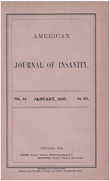Demonstration in vivo of reduced serotonin responsivity in the brain of untreated depressed patients [published erratum appears in Am J Psychiatry 1996 Apr;153(4):588]
Abstract
OBJECTIVE: For over 25 years, it has been hypothesized that major depression is due to a deficiency of available serotonin or subsensitivity of key serotonin receptors in relevant brain regions. Direct evidence supporting this hypothesis has been lacking because of the difficulty in studying regional brain serotonergic function. The authors have developed a method for visualizing in vivo regional brain responses to serotonin release by comparing regional brain glucose metabolism after administration of the serotonin-releasing drug dl- fenfluramine, relative to placebo. METHOD: Results with healthy subjects (N = 6) were compared to those obtained with drug-free inpatients with moderately severe major depression (N = 6). RESULTS: Healthy subjects had several areas of statistically significant increases in metabolism, mostly in the left prefrontal and temporoparietal cortex, and areas of decreased metabolism, such as in the right prefrontal cortex. In contrast, the depressed patients had no areas of increase or decrease in metabolism, differing significantly from healthy subjects. Results with patients resembled those with healthy subjects (N = 10) who were scanned twice without active drug on either occasion. CONCLUSIONS: This study provides the first direct visualization of blunted regional brain responses to serotonin release in the brain of patients with major depression, a finding that supports the hypothesis of impaired serotonergic transmission in depression.
Access content
To read the fulltext, please use one of the options below to sign in or purchase access.- Personal login
- Institutional Login
- Sign in via OpenAthens
- Register for access
-
Please login/register if you wish to pair your device and check access availability.
Not a subscriber?
PsychiatryOnline subscription options offer access to the DSM-5 library, books, journals, CME, and patient resources. This all-in-one virtual library provides psychiatrists and mental health professionals with key resources for diagnosis, treatment, research, and professional development.
Need more help? PsychiatryOnline Customer Service may be reached by emailing [email protected] or by calling 800-368-5777 (in the U.S.) or 703-907-7322 (outside the U.S.).



